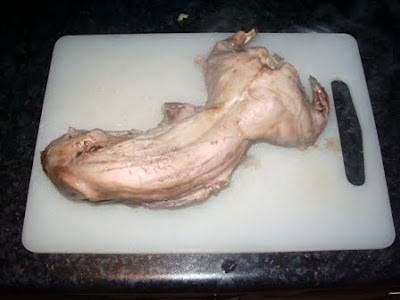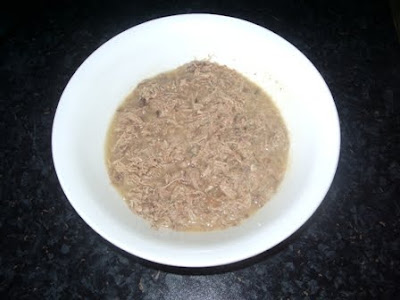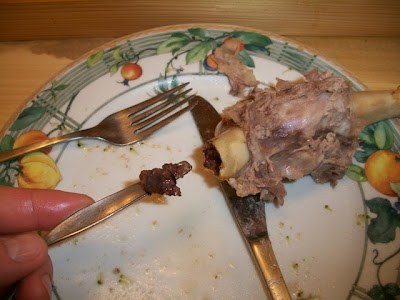
Last year a lady I work with asked me about Paleo/Primal as an approach to weight loss. So I gave her the elevator pitch. Well okay, in fact I pinned her down and talked until she developed 'the glaze', then later sent links to various articles, blogs and, of course, the
Nutshell video.
A couple of weeks later, she confessed that she'd not read the information. She'd been very busy.
But the truth was, she didn't really want that much detail. Not everyone wants to know why - they just want to know
how.
So I agreed to send her an email telling her what to do and skipping the science and anthropology lecture. When I'd finished, it occurred to me that many of you probably find yourselves in the same position with friends and relatives.
So here it is - the Paleo/Primal Friends and Family Email Template - copy it, customise it and send it. I hope it saves you some time
.
------------------------------
Dear [name]
As discussed, here is a one-pager which I hope will get you started on Paleo/Primal without daunting you with too much science and history. If you decide to give it a go and have any questions once you get started, just drop me a line.
All the best,
[me]
-----------------------------
Summary
You will be shifting from a high-carb diet, which includes processed foods and sugar, to a low-carb, possibly higher protein, definitely higher fat diet which excludes starchy carbohydrate and sugar.
This will seem counter-intuitive because of the fat makes you fat and causes heart disease dogma which is, take my word for it, a load of crap (I have more info on that if you want it.) This may sound like ‘fake moon landings’ conspiracy theory, but you’ll just have to trust me.
You can shift about 2 lbs a week by sticking to this way of eating. Bear in mind that the first week may see a greater weight loss if your current diet contains more salt.
What to Eat
Meat, seafood, eggs, vegetables, salad, fruit (but not too much), nuts, seeds.
What not to eat
Bread, rice, pasta, potato, cereal, wheat, dairy, beans, any processed food, sugar.
The Fat Question
Fat is healthy – even saturated fat. The one type of fat to avoid is vegetable fat. This means margarine, vegetable cooking oils and processed foods that contain vegetable oil. In addition, whilst eating the fat from free-range animals is healthy, eating animal fats from industrially farmed animals is not as healthy. Avoid the latter if you can.
How Much Protein?
Just follow your nose on this one – eat as much meat/fish/eggs as feels natural, but if you are not normally much of a meat-eater you will need to make an effort to eat more. Most people have been conditioned to eat less meat that they should by the regular appearance of brown starchy crap alongside, which displaces those calories.
The Subtleties
If you have to eat dairy, stick to cheese – it’s low carb. Choose free-range meat, non-farmed fish and organic eggs. If I told you what I know about farming processes you’d never eat factory animals again anyway.
Ham is not meat, nor are most of the ghastly packets of sliced stuff peddled by supermarkets.
Don’t guzzle fruit juice. Ideally ditch it. Likewise dried fruit – it’s just proxy sugar.
Drink booze as little as possible, but feel free to have a few glasses of wine when you fancy it. Clearly booze is calories and probably carbs too unless you are on the neat vodka, so just bear in mind that more booze generally affects progress with the weight loss. Don’t get rubbered or you will head for the cakes and blow the lot in one night. Take it from me.
Food Ideas and Cooking Suggestions
It’s quite hard to eat enough fat at first. Here are some excellent sources: extra virgin olive oil, nuts, coconut, avocado, animal fat (don’t cut the fat off free-range meat – it’s good for you!)
Coconut is incredibly healthy. Use coconut oil for cooking instead of vegetable oils. Buy coconut cream/milk in tins and creamed coconut in a block/sachet. Great for cooking as a cream substitute.
Look out for nut butters. Not that you’ll be needing it for bread - I cook with it or put it on the side of the plate with meals; or just eat it by the spoonful as a treat. Mmmm!
In the evening just cook like you would normally cook, but skip the starchy brown stuff. Do more veggies, more meat and eat the fat. Try using extra virgin olive oil generously on your veggies if your meat or fish is lean.
Pudding – fruit/nuts with coconut cream.
Lunch pots for work – tinned fish and salad with avocado. Boiled eggs in salad. Leftovers from the night before, like cold chicken.
Breakfast - scrambled eggs, omelet, fruit, nuts etc. Not cereal – it’s the devil’s work.
Snacks - nuts and seeds are a great way to fill the gap when you are still hungry after a meal or need a snack.
Isn’t this Like the Atkins Diet?
Yes, insofar as it’s a low carbohydrate diet. But Atkins did not care so much what you ate: he just restricted the amount of carbohydrate you could eat. Some people abused this and ate nothing but clotted cream, bacon and one slice of white bread per day, so Atkins got a bad reputation.
Paleo/Primal ensures not only low carb but that the food is consistent with what hunter gatherers ate, which, funnily enough, is nutritionally excellent and what our bodies were designed for.
How Does it Work?
First of all, carbohydrate is not so good at satisfying your appetite and usually causes blood sugar to rise and fall in a short space of time.
Fat and protein, on the other hand, are good at satisfying your appetite. So you naturally eat fewer calories without needing to go hungry all the time.
In addition, there are two other important effects of eating low carb: it inhibits your body’s fat storing mechanisms and promotes your body’s fat burning mechanisms - which funnily enough usually leads to a reduction in body fat!
Exercise
Exercise is not necessary for the weight loss, but can contribute to success - and of course is good for you!
But don’t do lots of cardio. It simply increases your appetite and makes you crave carbs. Daily, grinding cardio was never something we were built for, and in any case if you are trying Paleo/Primal over just a few weeks then it will definitely sabotage your efforts in an unadjusted body and may affect your energy levels.
By 'unadjusted', I mean this: when you eat low carb for 6-8 weeks, your body’s energy systems re-align to use fat as an energy source; so once you get to that point, doing occasional longer cardio sessions is fine.
To start with, however, short, intense, interval-based exercise is the best companion to the program. For example, 15–30 minutes of weight training, or any activity where you exert maximum effort for short bursts, then rest in between (cycling, sprinting, swimming, circuit training.)
Less is more. Your metabolism works for you through the rest of the day. If you work hard enough, 10 mins is all you need. Ideally, no more that 2-3 times a week.
Finally...
Don’t obsess about whether you are getting enough of this or enough of that. Just avoid, the bad, focus on the good and it should take care of itself. You instinctively know when you are overeating, so try not do do it too often.
Take solace in the fact that you are doing yourself a lot of good in the process - this is a very healthy way to live: the weight loss is an incidental by-product.
-----------------------------... Read more
 Many corporations, lobbyists and establishments favour the pursuit of money over the health of human beings. I don't often write about it because it's too depressing - but I got a little out of my system in the first Nutshell video and last year's article about HFCS.
Many corporations, lobbyists and establishments favour the pursuit of money over the health of human beings. I don't often write about it because it's too depressing - but I got a little out of my system in the first Nutshell video and last year's article about HFCS.





 . After the meal, these were the bits left to slow cook
. After the meal, these were the bits left to slow cook  , and this was the result after several hours of slow cooking with some stirring to separate the meat from the bones:
, and this was the result after several hours of slow cooking with some stirring to separate the meat from the bones:  . These were the bones I picked out
. These were the bones I picked out  and this was what was left
and this was what was left  . Finally, after some additional ingredients, the soup:
. Finally, after some additional ingredients, the soup:  . This is how those ingredients are added:
. This is how those ingredients are added: and this was the meal it made
and this was the meal it made  . This was the leftover carcass
. This was the leftover carcass  and these are were broken up pieces in the slow cooker
and these are were broken up pieces in the slow cooker  . After slow cooking and manual bone removal, these were the separate components:
. After slow cooking and manual bone removal, these were the separate components:  . The contents of the bowl went into a pan and while that heated up an onion was chopped, steamed
. The contents of the bowl went into a pan and while that heated up an onion was chopped, steamed 
 and added
and added  . This was blended and some tomato puree added
. This was blended and some tomato puree added  . In this case, I added the coconut cream cold
. In this case, I added the coconut cream cold 
 , threw on a basil leaf, and it was ready to serve:
, threw on a basil leaf, and it was ready to serve:  .
. , creating this fine meal
, creating this fine meal  , there was this leftover carcass
, there was this leftover carcass  which went into the slow cooker like this
which went into the slow cooker like this  , came out like this
, came out like this  , and ended up making a couple of bowls of this:
, and ended up making a couple of bowls of this:  . I think we actually used spinach in that case.
. I think we actually used spinach in that case. . The fiddly step where you take out the bits from the slow cooked mixture is especially fiddly for crab shell; but crab soup with bits of crab meat included is much nicer than crab soup without, so again, it's worth the effort.
. The fiddly step where you take out the bits from the slow cooked mixture is especially fiddly for crab shell; but crab soup with bits of crab meat included is much nicer than crab soup without, so again, it's worth the effort. to make this meal
to make this meal  , after which I set about the bone to eat any remaining meat
, after which I set about the bone to eat any remaining meat  . You can see the marrow in this shot
. You can see the marrow in this shot  , then here
, then here  how I managed to scoop it out with the handle of a spoon. I then spend a while sucking and banging the other end, from which eventually I managed to get the rest of the marrow out.
how I managed to scoop it out with the handle of a spoon. I then spend a while sucking and banging the other end, from which eventually I managed to get the rest of the marrow out. , I once wondered whether I could increase the nutritional value of the soup by breaking open the bones and squeezing out the marrow into the soup mixture. This I did with the help of some pliers
, I once wondered whether I could increase the nutritional value of the soup by breaking open the bones and squeezing out the marrow into the soup mixture. This I did with the help of some pliers 

 . It was quite an effort.
. It was quite an effort.
 . There was nothing left at the end. The middle parts of the larger bones were a little harder to chew, but this only applied to one or two.
. There was nothing left at the end. The middle parts of the larger bones were a little harder to chew, but this only applied to one or two.







